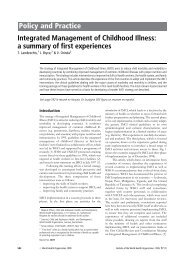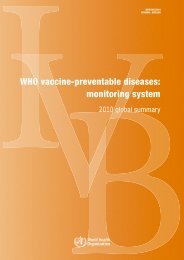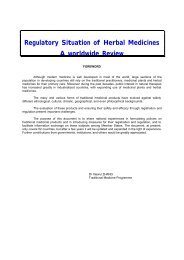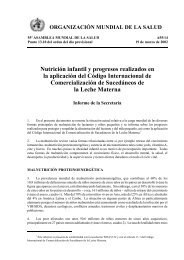IPDE - Extranet Systems - World Health Organization
IPDE - Extranet Systems - World Health Organization
IPDE - Extranet Systems - World Health Organization
Create successful ePaper yourself
Turn your PDF publications into a flip-book with our unique Google optimized e-Paper software.
76 A. W. Loranger<br />
Table 7. Interrater reliability and temporal stability of 1571PDE items<br />
Interater reliability (N=141) Temporal stability (N=243)<br />
Intraclass<br />
R No. of Items % Cumu1.B No of Items % Cumul. %<br />
0.90-1.00 13 8.3 0 (2) 0 (1.3)<br />
0.80-0.89 72 45.9 54.2 2 (13) 1.3 (8.3) 1.3 (9.6)<br />
0.70-0.79 52 33.1 87.3 14 (42) 8.9 (26.8) 10.2 (36.3)<br />
0.6&0.69 12 7.6 94.9 62 (62) 39.5 (39.5) 49.7 (75.8)<br />
0.50-0.59 4 2.5 97.4 53 (27) 33.8 (17.2) 83.4 (93.0)<br />
0.40-0.49 1 0.6 98.0 19 (5) 12.1 (3.2) 95.5(96.2)<br />
~0.40 3 1.3 7 (6) 4.5 (3.8)<br />
Kappa' was used to measure the interrater agreement and temporal<br />
stability of the PD diagnoses. Because of its instability in samples<br />
with an infrequent number of cases of a disorder, the recommendation<br />
was followed that it be calculated only when the prevalence of a disorder<br />
is at least 5%.4 To provide more opportunities for the calculation of<br />
kappa, it was also determined by combining definite and probable diagnoses.<br />
The <strong>IPDE</strong> assigns a probable diagnosis when a subject meets one<br />
criterion less than the number required for the diagnosis. An overall<br />
weighted kappa was also determined for all PDs, including those with a<br />
base rate of less than 5%. It was calculated by weighing each category of<br />
PDs by the total number of cases assigned a diagnosis in that category by<br />
either rater, regardless of whether or not the raters agreed about the diagnosis.<br />
The numerator is the sum of the product of the diagnostic weight<br />
and kappa for each disorder; the denominator is the sum of the weights.<br />
The kappa values are presented in Table 9.<br />
References<br />
1 Ebel, R.L. Estimation of the reliability of ratings. Psychometrikn. 1951; 16:<br />
407-23.<br />
2 Nu~ally, J.C. Psychomtric Theov, pp. 219-20, 237-9. New York, NY:<br />
McGraw-Hill InternationalBwkCo, 1978.<br />
3 Fleiss. J.L. S~atisrical methods for Rates and Proportions, 2nd edn., pp. 217-20.<br />
New York: John Wiley & Sons Inc, 1981.<br />
4 Grove, W.M., Andreasen, N.C., McDonald-Scott, P,. Kella, M.B. & Shapiro,<br />
R.W. Reliability sludies of psychiatric diagnosis: theny and practice. Archives<br />
of GenemlPsychiatry, 1981; 38: 408-13.

















